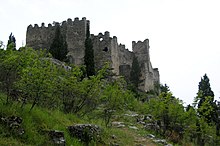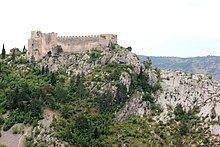Stjepan grad fortress
Stjepan Grad ( Bosnian / Croatian Tvrđava Stjepan grad ) is the name of a fortress above the Herzegovinian town of Blagaj (near Mostar ), which goes back to Duke Stjepan Vukčić Kosača . Only ruins remain from the medieval fortress.
location
The castle is located on a rocky mountain dominating the valley about 1000 meters as the crow flies east of the city center. South of the castle is Vrelo Bune, a strong karst spring.
history
The Illyrian tribe Daorsi (Dauersii, Daorsei) built between the 3rd and 2nd centuries BC. A fortified settlement on the summit of the upper reaches of the Buna . The Romans converted this into a field camp (castrum). In the 10th century, the castle, built on the ruins of the ancient Roman fortress walls, had become the center of the Hum region . In the period that followed, various rulers made the fortified city their own: in the 11th century, the princes of Zeta from the heart of today's Montenegro occupied the castle. It was then ruled by the Serbian Prince Stefan Nemanja . In the first Bosnian state, the castle came into the possession of the Bosnian kings and in 1428 it came into the possession of the Kosača feudal family. Before the Turks conquered the region, the fortress finally came into the possession of Duke Stjepan Vukčić Kosača. The current name of the fortress is derived from his first name. In 1465 the Turks conquered the castle and enlarged it with large towers, five entrenchments, a dungeon and a mosque. The entrance was protected by an iron-studded door. In 1827 the facility was badly damaged in an earthquake and was finally abandoned in 1835.
Others
The Bosnian Queen Katarina Kosača-Kotromanić was born here.
literature
- Marko Plesnik: Discover Bosnia-Herzegovina. On the way between the Sava and the Adriatic. Trescher Verlag 2007, ISBN 978-3897940659
Web links
- Brief description (English)
- Image ( Memento from January 2, 2011 in the Internet Archive )
Coordinates: 43 ° 15 ′ 36 " N , 17 ° 54 ′ 9.7" E

